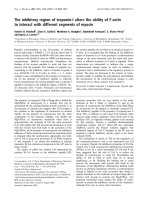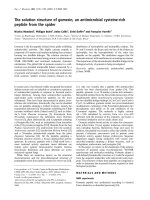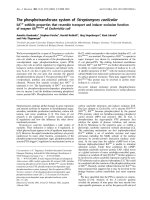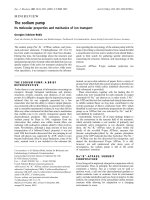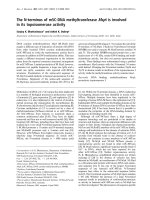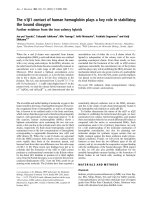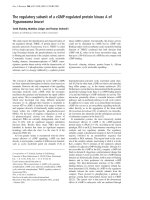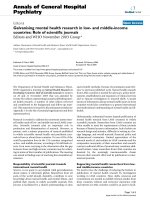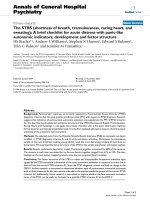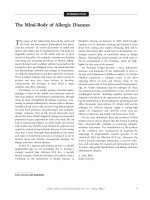Báo cáo y học: "The mental health of populations directly and indirectly exposed to violent conflict in Indonesia" pot
Bạn đang xem bản rút gọn của tài liệu. Xem và tải ngay bản đầy đủ của tài liệu tại đây (397.37 KB, 9 trang )
RESEARC H Open Access
The mental health of populations directly and
indirectly exposed to violent conflict in Indonesia
Sherly S Turnip
1,2*
, Ole Klungsøyr
3
, Edvard Hauff
1,3
Abstract
Background: Large disasters affect people who live both near and far from the areas in which they occur. The
mental health impact is expected to be similar to a ripple effect, where the risk of mental health consequences
generally decreases with increasi ng distance from the disaster center. However, we have not been able to identify
studies of the ripple effect of man-made disaster on mental health in low-income countries.
Objectives: The objective was to examine the hypothesis of a ripple effect on the mental health consequences in
populations exposed to man-made disasters in a developing country context, through a comparison of two
different populations living in different proximities from the center of disaster in Mollucas.
Methods: Cross-sectional longitudinal data were collected from 510 Internally Displaced Persons (IDPs) living in
Ambon, who were directly exposed to the violence, and non-IDPs living in remote villages in Mollucas, Indonesia,
who had never been directly exposed to violence in Mollucas. Data were collected du ring home visits and
statistical comparisons were conducted by using chi square tests, t-test and logis tic regression.
Results: There was significantly more psychological distress “caseness” in IDPs than non-IDPs. The mental health
consequences of the violent conflict in Ambon supported the ripple effect hypothesis as displacement status
appears to be a strong risk factor for distress, both as a main effect and interaction effect. Significantly higher
percentages of IDPs experienced traumatic events than non-IDPs in all six event types reported.
Conclusions: This study indicates that the conflict had an impact on mental health and economic conditions far
beyond the area where the actual violent events took place, in a diminishing pattern in line with the hypothesis of
a ripple effect.
Background
A number of factors have been identified as having an
impact on the mental health of populations affected by
disasters [1-3]. The g eographical distance from the cen-
tre of the disaster is one of the factors that is likely to
influence such an impact. This has been described as
the ripple effect of a disaster, and posits that mental
health problems spread outward from the center of dis-
aster in a diminishing ripple pattern [4-6]. Disaster spa-
tial zones describe the area at the center of disaster as
“area totally destroyed”,theimmediateareaaroundthe
disaster center as “partially destroyed area”, and the area
adjacent to the impact area as the “ filter zone” [7].
In populations, exposure level is a fundamental
determinant of the mental health effects of disasters
[8,9]. Previous studies indicate that those directly
exposed to severe incidents are likely to have the highest
risk of PTSD and other psychiatric problems [10], and
the risk of mental health consequences generally
decreases with increasing distance from the disaster
agent and de creasing exposure of affected individuals
[11].
Man-made disasters often causemorefrequentand
more persistent psychiatric symptoms and distress than
natural disasters [12]. Man-made disasters with a high
degre e of community d estruction, and those in develop-
ing countries, are associated with the worst outcomes
[13]. A meta-analysis of mental health of displaced per-
sons indicated that internally displaced persons and
those who fled due to unresolved conflict were most
affected and had the worst mental health outcomes com-
pared to the refugees lived in developed countries [14].
* Correspondence:
1
Division of Mental Health and Addiction, Institute of Clinical Medicine,
Faculty of Medicine, University of Oslo, Oslo, Norway
Turnip et al. Conflict and Health 2010, 4:14
/>© 2010 Turnip et al; licensee BioMed Central Ltd. This is an Open Access article distributed under the terms of the Creative Commons
Attribution License (http://creativecom mons.org/licenses/by/2.0), which permits unrestricted use, distr ibution, and reproductio n in
any medium, provided the original work is properl y cited.
However, most stud ies on the ment al health conse-
quences of disaster have been of natural disasters. They
showed that the impact on populations in third world
countries differs depending on the proximity to the disas-
ter center [1-3,15]. We have not been able to identify any
studies of the impact of man-made disasters on the men-
tal health of indirectly exposed communities in low-
income countries. Such information is important in order
to assess which populations segments that are in need of
different types of assistance.
The present study investigates the impact of long-term
violent conflict in Molluca s, Indonesia. The violence,
which is believed to be related to religious conflicts
between Moslems and Christians, lasted for six years
(1999-2005). It spread from its origin in Ambon city to
other islands but did not reach a small number of vil-
lages in neighboring islands. Although these remote vil-
lages were never exposed to direct violence from the
Mollucas conflict, reports showed that the non-IDPs liv-
ing there were affected by it. Indirect effects, such as
shortages of life supplies, unavailability of health care,
lack of education for children, unverified news related
to the conflict and difficulties commuting to other
islands and villages due to transportation shortages,
were some of the major problems [16]. This paper aims
to investigate the hypothesis of a ripple effect on the
mental health of populations exposed to violent conflicts
by comparing two different populations, namely intern-
ally displaced persons (IDPs) who lived in Ambon and
were directly exposed to the violence and those who
lived in remote villages that had never been directly
exposed to violence (non IDPs). We hypothesized that
the non-IDPs in remote villages experienced the violent
conflict in a pattern in line with the ripple effect, indi-
cated by lower level and lower prevalence of distress,
less traumatic experiences and better economic condi-
tions than IDPs living in Ambon. We also hypothesized
that there would be different risk factors of distress in
both communities.
Methods
Study design
This study used cross-sectional data, which were col-
lected as part of a longitudinal study. We compared
data from IDPs and non-IDPs, two different types o f
communities in Ambon, Indones ia, with different proxi-
mities to the violent conflict. IDPs data were collected
in a longitudinal community based study on Ambon
Island over two consecutive years (2005-2006). For this
paper, we used data recorded in the second data collec-
tion, which was conducted from August to October
2006, and compared it with n on-IDPs data collected in
September 2006. Ethical clearance was obtained from
the Faculty of Psychology, Universitas Indonesia.
Procedure
Lists of households were requested and obtained from
each resettlement and village leader. We randomly
selected 471 participants from each list. Details of the
randomized sampling procedure used in the study are
explained in a previous paper [17]. Local assistants, who
were IDPs themselves, underwent specific training for
theprojectandcollectedthedataduringhomevisits.
After giving informed consent, the respondents were
asked t o fill in the questionnaires by themselves, in the
presence of an assistant in case the respondent had any
questions regarding t he items. I f a responde nt was not
capable of completing the questionnaire on his or her
own, the assistant would help by reading each item
aloud to the respondent and writing down their
responses.
Sample
IDPs participant
The inclusion criteria were IDPs living on Ambon Island
during and after the violent period who were o ver 18
years of age and had sufficient competency in Bahasa
Indonesia. The exclusion criteria were having a hearing
problem, mental retardation or deme ntia (psychologists’
assessment).
Ten locations were selected, based on their accessibility
by transportation means from Ambon city, from approxi-
mately 85 camps and relocation areas with different liv-
ing conditions (three temporary camps, two independent
relocation areas, three s upported relocation areas a nd
two IDPs old land areas) to ensure that all types of IDPs
resettlements on Ambon Island were represented. We
approached 471 subjects who participated in the first
data collection, and 399 subjects agreed to take part in
the second data collection in 2006 (83%).
Non-IDPs participant
The communities that lived in areas that had never been
exposed directly to violent conflict in Mollucas were
call ed non-IDPs. These areas have never been the scene
of violent conflicts and therefore do not have any IDPs,
probably due to the homogeneity of religion among the
inhabitants. A cross-sectional data collection was carried
out in B uru and Sa parua Islands in t he archipelago of
Mollucas p rovince in September 2006. Both islands are
located approximately 300-400 kilomet ers from Am bon,
and it took up to 15 hours to reach them with ferries
and cars. One village was chosen from each island; Booi
village on Saparua Island, and Kayeli village on Buru
Island. Those two villages were selected because there
had not been had a ny incident related to the Mollucas
conflict w ithin the village, less than 5% of their inhabi-
tants had participated actively in the Mollucas conflict
outside their own village (according to information fr om
local district and village l eaders), and they were
Turnip et al. Conflict and Health 2010, 4:14
/>Page 2 of 9
geographically accessible by public transportation. Inclu-
sion criteria for participants were that they had lived in
the selected villages during and after the violent period
(in the past six years), were over 18 years of age, had
never been actively involved in the Mollucas violent
conflicts, were sufficient ly competent in Bahasa Indone-
sia, and did not have hearing problems, mental retarda-
tion or dementia (psychologists’ assessment). We
collected the names of the villagers from the village
leaders and randomly picked 120 participants in both
villages. Of the 120 people we approached, 111 agreed
to participate in the study (93%).
Measures
Demographic section
This section measured basic demographic information
including age, gender, education, displacement status,
marital status, religion and address. The map of the
study area is presented in Figure 1.
Psychological distress
The Hopkins Symptoms Check List-25 (HSCL-25) was
used to measure psychological distress in the past week
[18]. Items are rated on a scale ranging from 1 (not at
all) to 4 (extremely). This instrument has been widely
used in studies of forced migrants in different countries
[19], including IDPs in low-income countries [19]. We
used the conventional criteria for determining “caseness”
on the HSCL-25 measure; a score ≥ 1.75 was taken as
an indication that the person probably needed a further
diagnosis of psychological distress [20-22]. The details
of the cultural validation of the HSCL-25 in the Indone-
sian setting have been described in another paper [17].
Sense of Coherence
The Sense of Coherence (SOC) is used as an indicator
of resiliency. The SOC is a g eneralized, long-lasting
view one has of the world and of living in the world.
This concept has three aspects: comprehensibility, man-
ageability and meaningfulness [23,24]. Some comparable
concepts associated with resiliency were “hardiness”
from Kobasa, “sense of permanence” from Boyce Tho-
mas, domains of social climate from Rudolf Moos, and
family’s construction of reality from David Reiss [23].
We used the short version of the Sense of Coherence
questionnaire (SOC), which consists of 13 items. The
SOC scale is a seven-point semantic differential Likert
scale. Conventionally, each item is scored from 1 to 7
for “positively” formulated items, with “negatively” for-
mulated items scored reversely. The scores are then
added to get the SOC score; a higher score indicates
higher SOC [23]. The SOC 13 has been used in low-
income countries and in postwar settings [24,25]. Before
collecting the data, we conducted a cultural validation
using the translation monitoring form [26]. T he process
includes the translation and back translation by different
persons followed by comparison o f the two translation
results by a bilingual mental health professional, evalua-
tion of the local language translation by focus group dis-
cussion of lay people and p ilot study. In this study, a
five-point scal e was chosen because it was strongly
advised by participants of the focus group discussion
(FGD) during the cultural validation. The sum of all
items was then multiplied by 7/5 to make the total
score comparable to other results [24]. This cultural
validation process ensured the relevance and meaning-
fulness of the sense of coherence concept in the local
culture in Mollucas. Preliminary interviews with tradi-
tional leaders showed that Mollucans believed in their
ability to rebound from difficulties. A Mollucan was
described to have similarities with the sago tree: rough
outside but white inside. This symbol represents the
characteristics of Moll ucans as being tough and resilient
with purity and sincerity at heart [27].
Figure 1 Violent conflict spatial zones in Ambon, Buru and Saparua Islands. A: Kayeli village in Buru Island. B: Ambon city in Ambon Island.
C: Booi village in Saparua Island
Turnip et al. Conflict and Health 2010, 4:14
/>Page 3 of 9
Traumatic experiences
Participants were asked about their traumatic experi-
ences during the conflict period. The questions were
derived from the most common traumatic experiences
amongIDPsinAmbon:witnessingmurder,feelingthat
one’s life was ever in danger, witnessing violence toward
people and/or property, having a close family member
who died due to the conflict and being injured herself/
himself due to the conflict. Those experiences were
identified through several focus group discussions
(FGD) and interviews with IDPs in Mollucas. All of the
questions were formulated as ‘yes’ or ‘no’ questions.
Economic conditions
We developed our socioeconomic and demographic
questionnaire in Ambon, based on the indicators from
the National Socio Economic Survey in Indonesia [28].
The poverty level was measured by three variables. The
first was a structural variable that consisted of five items
comprising educational level, disruption at school during
the conflict period, employment status and income and
gifts received from out side the household in the past
three months. The second was a consumption variable
that consisted of five food items and four nonfood items
designed to differentiate between the well-off and the
poor. The last was an asset ownership variable that con-
sisted of the 10 items that best defined one’ s socioeco-
nomic status in the local setting. The details of
development of this instrument are given in a previous
paper [17].
Statistical analysis
We conducted chi square tests to i dentify differences in
demographic characteristics and traumatic experiences
with respect to displacement status. In order to identif y
differences in distress scores and economic condition
indicators, we condu cted independent group t-tests
between IDPs and non-IDPs. Since we had the IDPs
data from two consecutive years, we also conducted
paired group t-tests within the IDP group on those two
occasions. Proportions of distress “caseness” were com-
pared between IDP and non-IDPs through logistic
regression analysis with psychological distress (case v s.
noncase) as the dependent variable, and the status (IDPs
vs. non IDPs) as independent variable.
The focus was the association between displacement
status and psychological distress. Various background
factors were considered to be pot ential confo unders and
adjusted for. We entered the background factors as
independent variables one by one into bivari ate regres-
sion analysis and retained all variables that were signifi-
cantatp≤ 0.1 for the multiple regression analyses.
Then all possible interactions and non-linearities we re
assessed and also retained for multiple regression analy-
sis at p ≤ 0.1. Model selection was done by comparing
different combinations of covariates in a stepwise fash-
ion and choosing the best-fit model. Only significant
terms were kept in t he final model. We used SPSS ver-
sion 14 for statistical analysis. All significance tests were
two-sided with significance levels of 0.05 [29].
Results
Demographic characteristics and traumatic experiences
report
The numbers of female and male participants in both
IDPs and non-IDPs groups were almost equal. The par-
ticipants in the IDPs group were 19-81 years, with a
mean age of 39 years (SD = 14.2), and participants in
the non-IDPs group were 18-79 years, with a mean age
of 43 years (SD = 16.2). There was a significantly higher
percentage of Christian participants in the non-IDP
group than in the IDPs, and a significantly larger per-
centage of IDPs participants had a higher level of educa-
tion than non-IDPs partic ipants. There was significantly
higher percentage of married people among the non-
IDPs compared to the IDPs. Other demographic charac-
teristics of the participants are presented in Table 1.
The comparison of the number of IDPs and non-IDPs
participants who experienced traumatic events i s pre-
sented in Table 2. Significantly higher percentages of
IDPs experienced each of the six kinds of traumatic
events reported than non-IDPs. The largest difference
was that more than half of the IDPs group reported hav-
ing witnessed violence toward property while only 4% of
the non-IDPs group had. The traumatic event most
commonly reported by IDPs and non-IDPs was feeling
threatened. The event least commonly reported by IDPs
Table 1 Demographic characteristics of communities
affected directly and indirectly by violent conflict in
Mollucas
IDPs (%)
N = 399
Non-IDPs (%)
N = 111
c
2
p
Gender
Female 235 (59) 59 (53) 1.174 0.279
Male 164 (41) 52 (47)
Age
< 30 years 118 (30) 27 (24) 1.176 0.278
≥ 30 years 281 (70) 84 (76)
Religion
Christian 224 (56) 78 (70) 7.179 0.007
Moslem 175 (44) 33 (30)
Education
< 9 years 144 (36) 60 (54) 11.179 0.001
≥ 9 years 255 (64) 51 (46)
Marital status
Married 304 (76) 94 (85) 129.40 < 0.001
Not married 95 (24) 17 (15)
Turnip et al. Conflict and Health 2010, 4:14
/>Page 4 of 9
was being injured in the conflict, while in the non-IDPs
group the least experienced event was witnessing
murder.
Mental health and economic conditions
The mean score of psychological distress in 2006 for the
total sample was 1.68 (SD = 0.46). The comparison of
mental health indicators and economic conditions
between IDPs and n on-IDPs is presented in Table 3.
There was no significant difference in crude distress
level betwe en IDPs and non-IDPs. We had data for the
IDPs distress score one year previously, which was 1.78
(SD = 0.50), significantly different from the distress level
of both IDPs and non-IDPs in 2006 (p = 0.001 and <
0.001 respectively). In the non-IDPs group there was no
sig nificant gend er dif ference in psyc hological distress (p
= 0.085). The distress mean scores for females were 1.66
(SD = 0.47) and for males were 1.56 ([SD = 0.43). In the
IDPs group, females had signifi cantly higher distress
levels than males (p < 0.001), where the distress mean
scores were 1 .78 [SD = 0.47] and 1.58 [SD = 0.44]
respectively.
There was significantly more “caseness” of psychologi-
cal distress in IDPs than in non-IDP (OR = 1.6, p =
0.042) as presented in Tabl e 4. There was no signific ant
difference in sense of coherence between IDPs and non-
IDPs.
Economic conditions of non-IDPs were significantly
better than IDPs with regard to the structural and asset
ownership variables (p < 0.001 for both variables), and
there was no significant difference in consumption
between IDPs and non-IDPs.
Risk and protective factors of distress
The regression model explained 23.6% variance of psy-
chological distress (Table 5). The variable with the lar-
gest contribution to explained variance was SOC (6.7%),
followed by gender (3.9%) and status of being IDPs or
non-IDPs (2.8%). Being IDPs was a risk factor for dis-
tress, while higher SOC was a protective factor. Other
risk factors for distress were being female, not being
married ( single and widowed), owning fewer assets and
feeling that one’s life was in danger. Interaction between
lower SOC and lower number of assets was a sig nificant
risk factor for distress. Significant interactions were
found between SOC and asset ownership, asset o wner-
ship and displacement status, and marital status and dis-
placement status. Owning fewer assets a nd not being
married showed a stronger negative association with the
distress levels of IDPs than non-IDP. IDP with fewer
assets were more distressed than non-IDPs with fewer
assets (Figure 2, upper panel) and IDP who were not
married were at an higher risk of distress than their
married counterparts and non-IDPs (Figure 2, lower
panel)
Discussion
The ripple effect of violent conflict
Our study foun d that the prevalence of psychological
distress in a population indirectly affected by violent
conflict was significantly lower than in a population in
the same region that was directly affected. This con-
firmed our hypothesis that there would be a ripple effect
of disaster across different proximities to violent con-
flict; our findings revealed that people who lived in
Table 2 Comparison of traumatic experiences between communities affected directly and indirectly by violent conflict
in Mollucas
IDPs (%)
N = 399
Non-IDPs (%)
N = 111
c
2
p
Threat 361 (77) 46 (41) 52.944 < 0.001
Injured 42 (9) 3 (3) 4.863 0.027
Witnessed murder 135 (29) 1 (1) 38.662 < 0.001
Witnessed violence toward people 181 (38) 5 (5) 47.543 < 0.001
Witnessed violence toward property 238 (51) 4 (4) 81.437 < 0.001
Family death 208 (44) 19 (17) 27.616 < 0.001
Table 3 Comparison of mental health indicators and economic conditions between communities affected directly and
indirectly by violent conflict in Mollucas
IDPs mean scores (SD) Non-IDPs mean scores (SD) Range of scores p
Psychological distress 1.70 (0.47) 1.62 (0.46) 1-4 0.112
Sense of coherence 65.3 (9.5) 65.7 (10) 18-91 0.682
Structural variable 13.3 (4.6) 14.7 (2.3) 2-24 < 0.001
Consumption variable 10.3 (4.5) 10 (3.9) 0-22 0.370
Asset ownership variable 12.2 (6.3) 15.5 (7.1) 0-31 < 0.001
Turnip et al. Conflict and Health 2010, 4:14
/>Page 5 of 9
exposed areas had higher distress levels, which w as in
line with the result s of other studies [4-6,30]. Figure 1.
presents the map of areas affected by the violent conflict
in Mollucas province. The results supported our hypoth-
esis that non-IDPs experienced less traumatic events
than IDPs. However, because four in ten participants
felt that their lives were threatened, and one in eight
had lost a close family member, the consequences of the
violence for the non-IDPs was still considerable. These
events can be experienced regardless of one’s physical
proximity to the conflict. Non-IDPs were still exposed
to the conflict by news delivered to them by television
and radio stations, newspapers, relatives living in
Ambon and people who had traveled to the area of con-
flict. Exposure through various media can lead to the
perception of frightening and life-threatening events
when an individual personalizes the events or views
themselves as a potential victim [31,32].
The hypothesis of a ripple effect on the economic
conditions was partially confirmed. The non-IDPs had
significantly higher levels of structural resources and
asset ownership than the IDPs. The non-IDPs lived in
conflict-f ree areas, so their houses, land and other assets
stayed intact. On the other hand, most of the IDPs had
lost their assets, such as houses and land, during the
forced migration that followed the conflict [16]. IDPs
also experienced more disturbance of education than
non-IDPs, which may lead to school dropouts and job
loss. However, both population groups had similar levels
of food and nonfood consumption. Most people in Mol-
lucas are still fulfilling their daily consumption needs
from their environment. Many people grow their own
vegetables or catch fish for their own families [33,34].
Furthermore, it was equally difficultforIDPsandnon-
IDPs to obtain nonfood consumption objects such as
clothes, health care and recreation equipment. The Mol-
lucas are located far from the big cities, and goods
transportation could be problematic during the conflict
and post-conflict period due to the destruction of eco-
nomic infrastructures [35].
The insignificant difference of distress level between
IDPs and non-IDPs in 2006 was probably relat ed to the
improvement of the economic conditions in the IDPs
areas (which were in the main island of Ambon) after
the peace condition resumed in 2005. Being the location
of the offices of the provincial government, Ambon
island had received substantial economic stimulation
activities which generated better income for most of its
inhabitants. The security level had also improved as to
attract national and foreign investors to the island.
Numerous IDPs resettlement project have been con-
ducted to speed up the recovery process. Those
improved conditions might be associated with the signif-
icant reduction of the IDPs distress level from the pre-
vious year, and became more similar to those of the
non-IDPs. On the other hand very little had changed in
the two islands where the non-IDPs respondents lived
after the conflict had ended. Progress in development
Table 4 Prevalence and odds ratio of distress cases
among communities affected directly and indirectly by
violent conflict in Mollucas
IDPs
(N = 399)
Non-IDPs
(N = 111)
p
Distress “caseness”
Frequency 165 34 0.041
Percentage 41 30
Odds ratio 1.6 1 0.042
95% CI 1.1-2.5
Notes
CI: Confidence interval
Table 5 Multiple regression analysis of risk factors of
psychological distress for communities affected directly
and indirectly by violent conflict in Mollucas
Variables Total sample ( N = 510)
B 95% CI p
Intercept 4.607 3.907-5.305 < 0.001
Displacement status (IDPs) 695 -1.060-(-0.331) < 0.001
Gender (male) 167 -0.241-(-0.094) < 0.001
Threat .105 0.021-0.188 0.014
Assets (higher) 068 -0.111-0.025 0.002
SOC (higher) 024 -0.033-(-0.016) < 0.001
Married 479 -0.768-(-0.189) 0.001
Assets * SOC .001 < 0.001-0.001 0.021
Assets * Displacement status .017 0.004-0.029 0.010
Marital status * Displacement status .260 0.026-0.495 0.030
Figure 2 Effect modification of displacement-distress relation
by assets (upper panel) and marital status (lower panel).
Turnip et al. Conflict and Health 2010, 4:14
/>Page 6 of 9
was very slow and people live the same kind of life that
they have endured since previous year, possibly even
years before.
Although there were significant differences between
IDPs and non-IDPs proportions in religions and educa-
tional level, we found no associations between these
variables and mental health in either community. There-
fore those demographic characteristics are not likely to
be associated with the psychological distress.
Risk factors for psychological distress
IDPs status appears to be an important risk factor for
distress, both as a main effect and an interaction effect.
This result indicated that there was a ripple effect from
the disaster, where closer proximity to the violent con-
flict would predict higher distress. The main d ifference
between IDPs and non-IDPs living conditions was the
proximity to the violent conflict and their exposure to
it. Previous studies demonstrated significant effects of
proximity to the epicenter of disaster on morbidity rates
and degree of psychological distress [1,36]. A study on
nationwide psychological responses to the September 11
terrorist attack in New York indicated that people
directly exposed to the event had significantly higher
post-traumatic stress symptoms than those indirectly
exposed [30]. As we found in our sample, those who ar e
indirectly exposed can be expected to show a lower pre-
valence of psychiatric problems [37].
Being female was a risk factor for distress for the
combined sample. Previous epidemiological studies in
general populations have shown that women suffer
more anxiety and depression than men [38]. In a post-
conflict situation like Mollucas, women often experience
moreupsettinglifeeventsandaremorevulnerableto
abuse, w hich may be related to adverse life conditions,
especially during the violence period [39-41]. Qualitative
inquiries indicated that although women did not suffer
of any gender based violence in the Mollucas conflict,
many of them have been the victims of increased
domestic violence since the conflict had started. In
times of hardship, women often have more responsibil-
ities and burdens in domestic areas, such as expanding
their social role and entering the job market. The role-
related overload of responsibilities that women have to
endure might contribute to the elevated risk of common
psychological distress [40,41].
Feeling that one’ s life was threatened was the trau-
matic event most commonly reported by IDPs and non-
IDPs, and a risk factor for distress for both groups.
Exposu re to the disaster, regardless of the distance from
it, awoke more intense fears of being the victim of vio-
lence and created distress among people [31,32]. We
found that the prev alence of the fear of losing one’s life
was lower in the non-IDP than in the I DPs (41% and
77% respectively), but it was a risk factor for distress in
the combined sample.
A lower score on asset ownership was a risk factor for
distress. However, results from the analysis of interac-
tion effects indicated that fewer assets among IDPs were
associated with higher distress than among non-IDPs.
Most of the IDPs had lost their assets during th e violent
conflict, and this made life more difficult. IDPs with the
fewest assets lived in greater poverty than other IDPs.
Fewer assets could mean that IDPs did not have a place
to live or land to cultivate.
Another significant risk factor for distress was marital
status . Those who were not married had higher distress
levels than those who were married. From the interac-
tion effect between marital status and IDPs status, we
found that IDPs who were not married were at an even
higher risk of distress than their married counterparts
and non-IDPs. Previous studies have found that being
single or having been formerly married were risk factors
for depression and anxiety symptoms [42,43].
Sense of coherence appeared to be a protective factor
from psychological distress for the combined sample of
IDPs and non-IDPs, both as main effect and as an inter-
action effect with increasing number of assets. One
might expect a higher SOC in a more stabile population
(non-IDPs), which we did not find. SOC is stabilized
around the age of 30 and it is considered as a trait [23].
The mean ages were 39 and 43 years for IDPs and non-
IDPs respectively, and therefore SOC is likely to b e a
stable trait for them. Although both communities felt
threatened by the conflict, their SOC appears not to be
affected by it. This finding complements previous stu-
dies that revealed a strong association between SOC and
positive outcome of mental health [44]. People with a
high SOC can cope with stressful situations better and
stay healthier than those with a low SOC [44,45]. The
interaction between asset ownership and SOC indicated
that people with lower SOC and fewer assets had the
highest distress in our sample.
Limitations
We obtained information about traumatic events at dif-
ferent times for the two sample groups. The first time
we collected data from the IDPs was in 2005, one year
after the last major violent incidents took place in
Ambon. We collected data from non-IDPs in 2006,
when we conducted the second data collection from the
IDPs. The time interval between the last violent conflict
and data collection may have caused some memory dis-
tortion regarding the questions of traumatic experie nces
among non-IDPs. The distortion might have caused
underreporting of traumatic events, and may make com-
parison with IDPs more difficult. The difference in psy-
chological distress we found might have been more
Turnip et al. Conflict and Health 2010, 4:14
/>Page 7 of 9
pronounced if we had obtained d ata from non-IDPs in
2005.
Another limitation is that we only collected data from
two communities in the pro vince of Moll ucas. There-
fore, we cannot analyze the ripple effect on people living
further from Ambon, such as those who live in the
more distant neighboring provinces.
Strengths
The main strength of this study is the uniqueness of the
data. As far as we are aware, it is the only study of the
ripple effect on mental health from a man-made disaster
with a high degree of community destruction in a devel-
oping country, despite the suggestion that such disasters
in low-income countries are associated with the worst
outcomes of mental health [13].
The instruments used in this study to measure mental
health and socioeconomic conditions had been culturally
validated. The details of the developmen t and validation
of the instruments have been described in another paper
[17]. Benefits resulting from this cultural validation were
probably the low refusal rate (17% and 7% among IDPs
and non-IDPs respectively) and positive feedbac k from
respondents. The cultural validation is a key issue in
enabling this study to obtain meaningful and high qual-
ity results.
The different response rates between the IDP and
non-IDP samples (83% and 93% respectively) were due
to conditions in the field. The IDPs sample list was
based on the list from the previous year and therefore
was not based on an updated list of the inhabitants in
the study areas. The research team could n ot find 57
participants due to their movement to areas outside
Mollucas or unknown address in Mollucas, and 4 parti-
cipants had passed away during the time interval
between 2005 and 2 006. Only 11 participants refused to
take part with various reasons (severe illness, very busy
with their activities, could not find a convenient time to
participate). On the other hand, we had an updated list
of villagers for the non-IDPs sample comprised of the
actual people lived in the village during the data collec-
tion. T herefore the return rate was much higher in the
non-IDPs sample. However, there is no assumption of
information bias since we did not find any significant
difference of distress between the IDPs who participated
in the second year study and those who were not.
Implications
This study has general implications for emerging the-
ories of the impact of violence and disasters on commu-
nities. The impact of threat may be expanded to a wider
range of communities in varying degrees of proximity
from the places where the conflict originated. The
individual level measurements used in this study were
essential since the appraisal o f the impact of a violent
conflict depends on individual perception although the
exposure was a collective and ecological one. Individual
responses toward one exposure may vary depending on
many factors such as previous life experiences, the mean-
ing given to the exposure by the person, individual losses
due to the exposure, etc. Our findings are in line with the
systemic or ecological contextual approach that indicates
that the impact of violence toward an individual or a
community is transposed to the society at large (macro-
level) [2]. The different levels of society are interwoven
and linked to each other so that violence rarely occupies
the dire ctly affected area only [2]. When one approaches
disaster areas, one may use the findings of our study to
provide assistance to the different levels of society.
This study can serve as a basis for more research.
Extension of the study, such as the expansion of the
sampling areas to other parts of Indonesia, might
improve the generalizability of the hypothesis of a ripple
effect of a disaster on psychological distress.
Author details
1
Division of Mental Health and Addiction, Institute of Clinical Medicine,
Faculty of Medicine, University of Oslo, Oslo, Norway.
2
Faculty of Psychology,
Universitas Indonesia Depok, Indonesia.
3
Division of Mental Health and
Addiction, Oslo University Hospital Oslo, Norway.
Authors’ contributions
SST: Did data collection, data analysis and drafted the manuscript. OK:
Involved in data analysis and in writing the manuscript. EH: Involved in data
collection, data analysis and writing the manuscript. All authors read and
approved the final version of the manuscript.
Competing interests
The authors declare that they have no competing interests.
Received: 26 February 2010 Accepted: 30 July 2010
Published: 30 July 2010
References
1. Cao H, McFarlane A, Klimidis S: Prevalence of psychiatric disorder
following the 1988 Yun Nan (China) earthquake. The first 5-month
period. Soc Psychiatry Psychiatr Epidemiol 2003, 38:204-212.
2. de Mel S, McKenzie D, Woodruff C: Mental health recovery after the
tsunami: High-frequency longitudinal evidence from Sri Lankan small
bussiness owners. Soc Science Medicine 2008, 66:582-595.
3. Frankenberg E, Friedman J, Gilespie T, Ingwersen N, Pynoos R, Rifai LU, et al:
Mental health in Sumatra after the tsunami. American J Public Health
2008, 98:1671-1677.
4. Galea S, Ahern J, Resnick H, et al: Psychological sequelae of the
September 11 terorist attacks in New York City. New England Journal of
Medicine 2002, 346:982-987.
5. Galea S, Vlahov D, Resnick H, et al: Trends of probable post-traumatic
stress disorder in New York City after the September 11 terorist attacks.
American Journal of Epidemiology 2003, 158:514-524.
6. Ursano RJ, Fullerton CS, Weisaeth L, Raphael B: Textbook of disaster
psychiatry Cambridge University Press UK 2007.
7. Weisaæth L: Stress reactions to an industrial disaster. An investigation of
disaster behaviour and acute post-traumatic stress reactions, and a
prospective, controlled, clinical and interventive study of sub-acute and long-
term post-traumatic stress reactions Oslo: University of Oslo 1984.
Turnip et al. Conflict and Health 2010, 4:14
/>Page 8 of 9
8. Abdo T, al-Dorzi H, Itani AR, Jabr F, Zaghloul N: Earthquakes: health
outcomes and implications in Lebanon. The Labanese Med Journal 1997,
45:197-200.
9. Baum A, Fleming R, Davidson LM: Natural disaster and technological
catastrophe. Environment and Behavior 1983, 15 :333-354.
10. North CS, Nixon SJ, Shariat S, et al: Psychiatric disdorders among survivors
of the Oklahoma City bombing. JAMA 1999, 282:755-762.
11. Shore JH, Vollmer WM, Tatum EL: Community patterns of posttraumatic
stress disorders. Journal of Nervous and Mental Disease 1989, 177:681-685.
12. Norris FH, Friedman MJ, Watson PJ: 60,000 disaster victims speak: Part II.
Summary and Implications of the disaster mental health research.
Psychiatry 2002, 65:240-260.
13. Davidson JRT, McFarlane AC: The extent and impact of mental health
problems after disaster. J Clin Psychiatry 2006, 67:9-14.
14. Porter M, Haslam N: Predisplacement and postdisplacement factors
associated with mental health of refugees and internally displaced
persons: a meta-analysis. JAMA 2005, 294 :602-612.
15. Alexander D: The health effect of earthquakes in the mid-1990s. Disasters
1996, 20:231-47.
16. Kompas Cyber Media National Indonesia newspaper published articles
on Ambon conflicts and wars in the period of 1999-2005. [http://www.
kompas.com/].
17. Turnip SS, Hauff E: Household roles, poverty and psychological distress in
internally displaced persons affected by violent conflicts in Indonesia.
Soc Psychiatry Psychiatr Epidemiol 2007, 42:997-1004.
18. Lipman RS, Covi L, Shapiro AK: The Hopkins Symptom Checklist (HSCL)-
factors derived from the HSCL-90. J Affect Disord 1979, 1:9-24.
19. Hollifield M, Warner TD, Lian N, Krakow B, Jenkins JH, Kesler J, Stevenson J,
Westermeyer J: Measuring trauma and health status in refugees: a critical
review. JAMA 2002, 288:611-621.
20. Derogatis LR, Lipman RS, Covi L: SCL-90: an outpatient psychiatric rating
scale - preliminary report. Psychopharmacology Bull 1973, 9:13-27.
21. Derogatis LR, Lipman RS, Rickels K, et al: The Hopkins Symptom Check
List. A self report symptom inventory. Behavioral Science 1974, 19:1-15.
22. Winokur A, Winokur DF, Rickels K, Cox DS:
Symptoms of emotional stress
in family planning service: stability over a four week period. Br J
Psychiatry 1984, 144:395-399.
23. Antonovsky A: Unraveling the mystery of health: how people manage stress
and stay well San Francisco: Jossey-Bass 1987.
24. Antonovsky A: The structure and properties of the sense of coherence
scale. Soc science & medicine 1993, 36:725-733.
25. Ghazinour M: Quality of life among Iranian refugees resettled in Sweden.
Journal of Immigrant Health 2004, 6:71-81.
26. Van Ommeren M, Thapa S, Makaju R, Prasain D, Bhattarai R, de Jong JT:
Preparing instruments for transcultural research: use of the translation
monitoring form with Nepali speaking Bhutanese refugees. Transcult
Psychiatry 1999, 36:285-301.
27. Latuconsina AG: Menggagas Masa Depan Maluku Yogyakarta: Intan
Cendekia 2007.
28. Survei sosial ekonomi nasional. Indonesia’s national socio-economic survey
National Statistical Body, Jakarta 2003.
29. SPSS Inc: Statistical package for the social sciences 2005.
30. Silver RC, Holman EA, McIntosh DN, et al: Nationwide longitudinal study
of psychological responses to September 11. JAMA 2002, 288:1235-1244.
31. Dixon P, Rehling G, Shiwach R: Peripheral victims of the Herald of Free
Enterprise disaster. Br J Med Psychol 1993, 66:193-202.
32. Pfefferbaum B, Gurwitch RH, McDonald NB, et al: Posttraumatic stress
among young children after the death of a friend or acquaintance in a
terrorist bombing. Psychiatr Serv 2000, 51:386-8.
33. Andaya LY: The world of Maluku: Eastern Indonesia in the early modern
period Honolulu: University of Hawaii press 1993.
34. Koning J, Nolten , Rodenburg , Saptari : Women and households in Indonesia
Richmond: Curzon press 2000.
35. Ambon Statistical Body. Kota Ambon dalam angka 2004 Percetakan Vensy
Karya Ambon, Ambon 2005.
36. Carr VJ, Lewin TJ, Webster RA, Hazell PL, Kenardy JA, Carter GL:
Psychosocial sequelae of the 1989 Newcastle earthquake: I. Community
disaster experiences and psychological morbidity 6 months post
disaster. Psychol Med 1995, 25:539-555.
37. Breslau N, Davis GC: Posttraumatic stress disorder in an urban population
of young adults: risk factors for chronicity. Am J of Psychiatry 1992,
149:671-675.
38. Sandanger I, Nygard JF, Sorensen T, Moum T: Is women’s mental health
more susceptible than men’s to the influence of surrounding stress? Soc
Psychiatry Psychiatr Epidemiol 2004,
39:177-184.
39. Nazroo JY, Eswards AC, Brown GW: Gender differences in the onset of
depression following a shared life event: a study of couples. Psychol Med
1997, 27:9-19.
40. Patel V, Kirkwood BR, Pednekar S, Weiss H, Mabey D: Risk factors for
common mental disorders in women. Population-based longitudinal
study. Br J Psychiatry 2006, 189:547-555.
41. Piccinelli M, Wilkinson G: Gender differences in depression. Critical
review. Br J Psychiatry 2000, 177:486-492.
42. Şalcioğlu E, Başoğlu M, Livanou M: Long-term psychological outcome for
non-treatment-seeking earthquake survivors in Turkey. The Journal of
Nervous and Mental Disease 2003, 191:154-160.
43. Guarnaccia P, Canino G, Rubio-Stipec M, Bravo M: The prevalence of
ataques de nervios in Puerta Rico disaster study. The role of culture in
psychiatric epidemiology. The Journal of Nervous and Mental Disease 1993,
181:157-165.
44. Eriksson M, Lindström B: Antonovsky’s sense of coherence scale and the
relation with health: a systematic review. J Epidemiol Community Health
2006, 60:376-381.
45. Cederblad M, Pruksachatkunakorn P, Boripunkul T, Intraprasert S, Hook B:
Sense of coherence in a Thai sample. Transcultural Psychiatry 2003,
40:585-600.
doi:10.1186/1752-1505-4-14
Cite this article as: Turnip et al.: The mental health of populations
directly and indirectly exposed to violent conflict in Indonesia. Conflict
and Health 2010 4:14.
Submit your next manuscript to BioMed Central
and take full advantage of:
• Convenient online submission
• Thorough peer review
• No space constraints or color figure charges
• Immediate publication on acceptance
• Inclusion in PubMed, CAS, Scopus and Google Scholar
• Research which is freely available for redistribution
Submit your manuscript at
www.biomedcentral.com/submit
Turnip et al. Conflict and Health 2010, 4:14
/>Page 9 of 9
